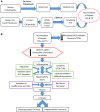Hepatic Steatosis in the Pediatric Population: An Overview of Pathophysiology, Genetics, and Diagnostic Workup
- PMID: 33868664
- PMCID: PMC8043692
- DOI: 10.1002/cld.1008
Hepatic Steatosis in the Pediatric Population: An Overview of Pathophysiology, Genetics, and Diagnostic Workup
Figures

References
-
- Nobili V, Alisi A, Valenti L, et al. NAFLD in children: new genes, new diagnostic modalities and new drugs. Nat Rev Gastroenterol Hepatol 2019;16:517‐530. - PubMed
-
- Buzzetti E, Pinzani M, Tsochatzis EA. The multiple‐hit pathogenesis of non‐alcoholic fatty liver disease (NAFLD). Metabolism 2016;65:1038‐1048. - PubMed
-
- Vos MB, Abrams SH, Barlow SE, et al. NASPGHAN clinical practice guideline for the diagnosis and treatment of Nonalcoholic fatty liver disease in children: recommendations from the expert committee of NAFLD (ECON) and the North American Soctiety of Pediatric Gastroenterology, Hepatology and Nutrition (NASPGHAN). J Pediatr Gastroenterol Nutr 2017;64:319‐334. - PMC - PubMed
Publication types
LinkOut - more resources
Full Text Sources
Other Literature Sources

